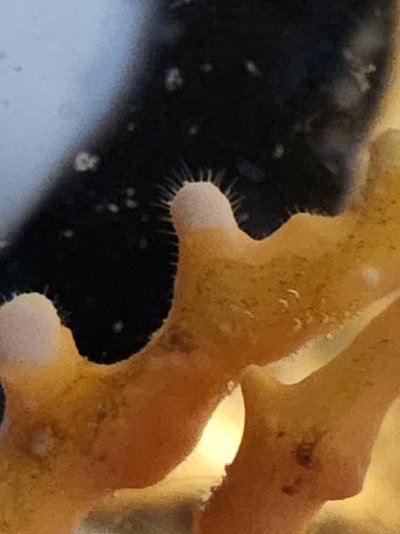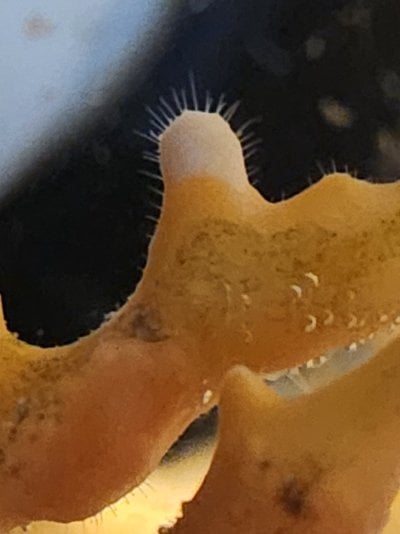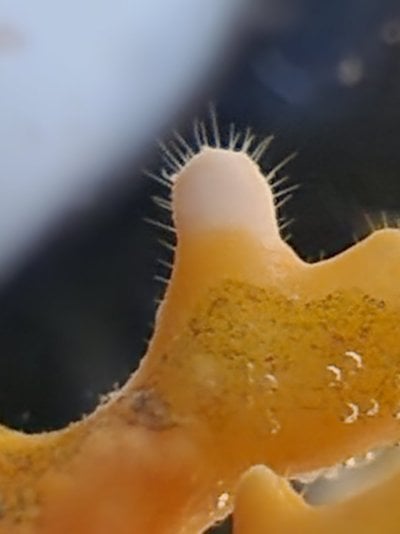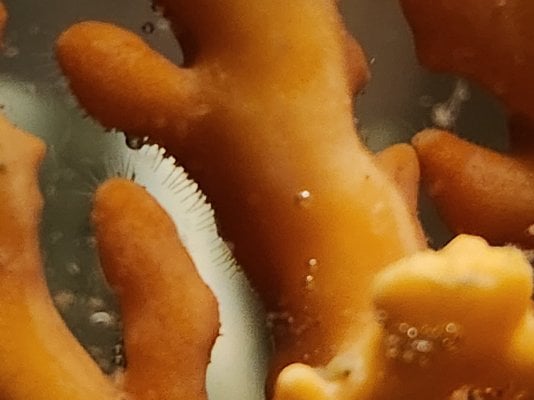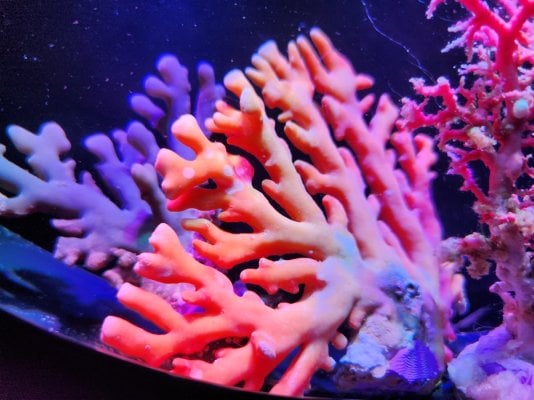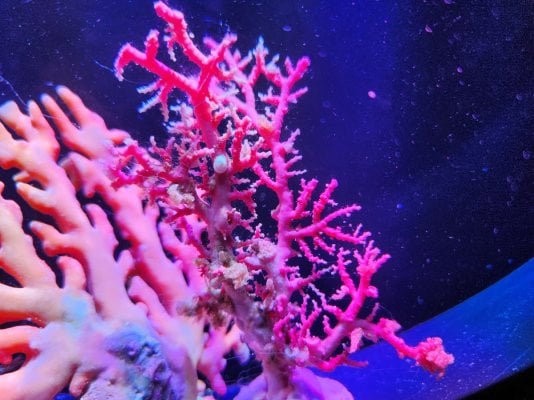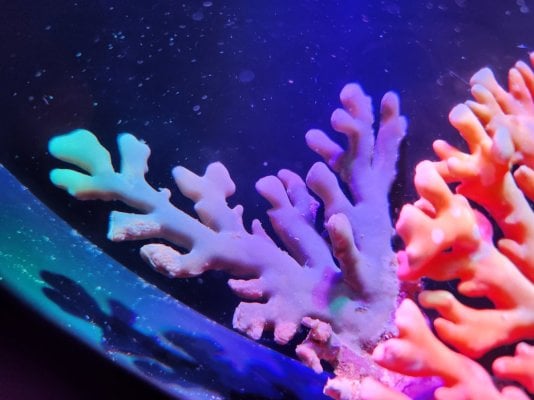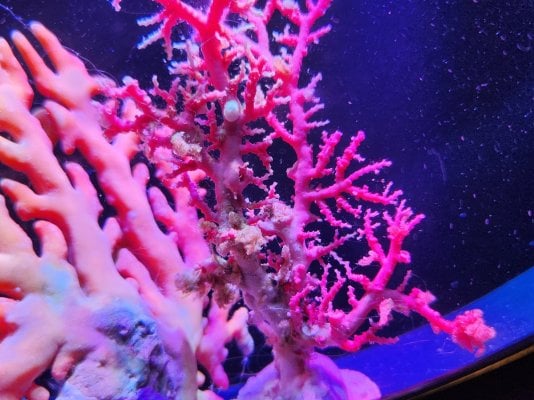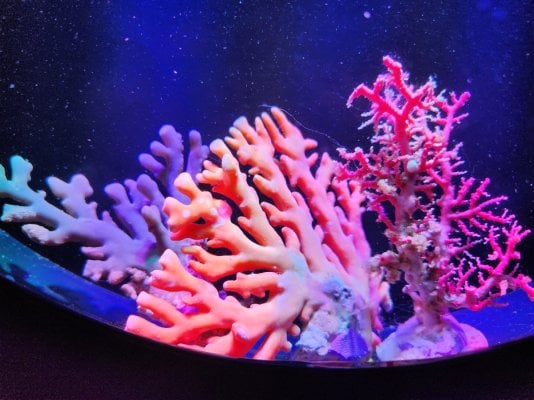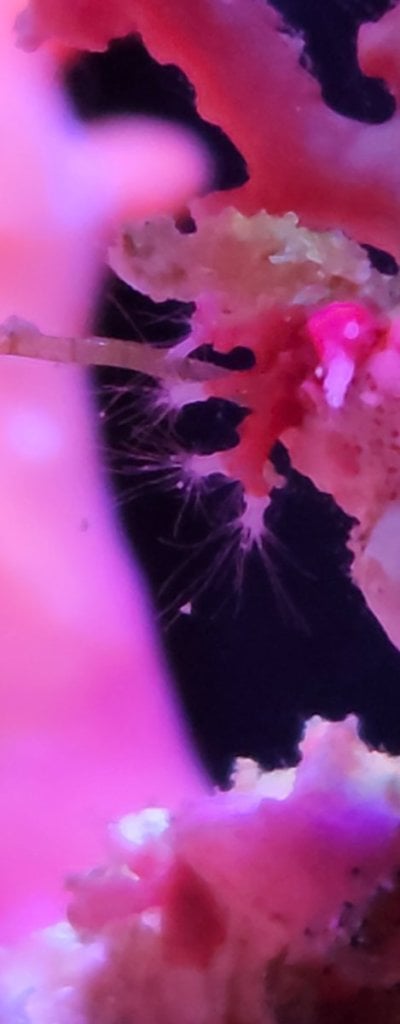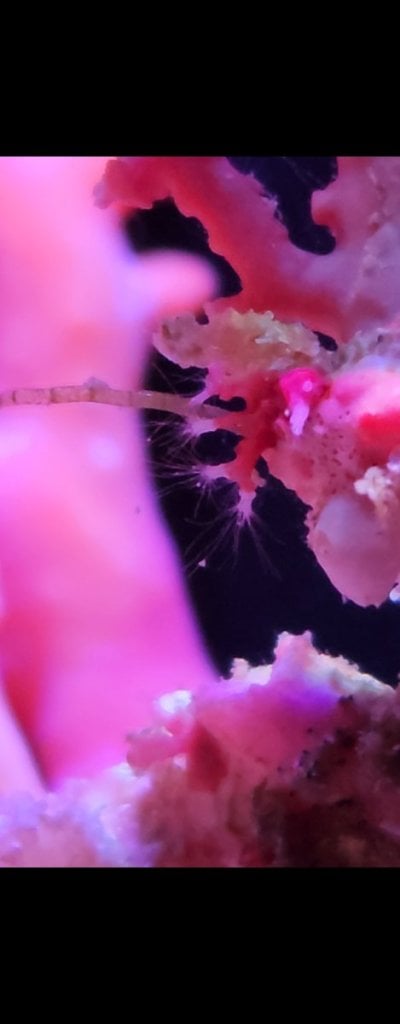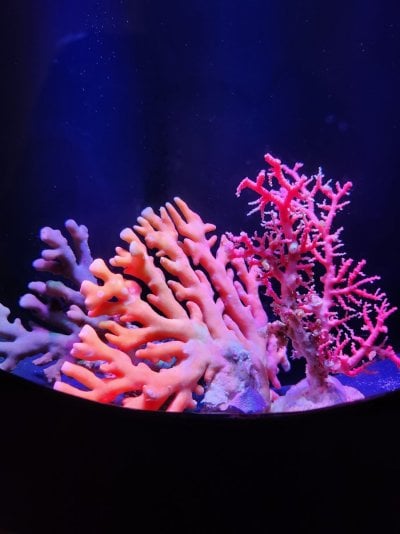(TLDR at bottom)
Unfortunately, I can't seem to find any specifics about what feeds these corals need. However, knowing how these species work from an anatomical perspective, and knowing what some of their relatives eat may be helpful for figuring out exactly what to feed them.
Basically, these species have three types of polyps:
1) Gastrozooids (the stomachs of the colony; these are typically relatively large)
2) Dactylozooids (the food gathering/defensive polyps of the colony; these are typically much smaller)
3) Gonophores (the reproductive polyps; almost all Stylasterids are dioecious/gonochoristic, so each colony is either male or female)
Gastrozooids and dactylozooids are the important types here. Essentially, any "prey" needs to be small enough to be taken down by the dactylozooids and ingested by the gastrozooids. From what I can find, the gastropores (the holes the gastrozooids live in) are typically anywhere from ~100-500 microns in diameter (depending on species and the individual pore) and ~3x the diameter of the pore in length (so if the pore is ~150 microns in diameter, then I'd estimate the pore extends into the skeleton ~450 microns in length), and the dactylopores seem to typically be ~1/4 to 1/5 the diameter of the gastropores for Stylasterids (though a few species have substantially smaller or substantially larger dactylopores) and substantially shorter.
Unfortunately, I don't know the sizes of the Stylasterid gastrozooids themselves, so I don't know how large they can expand to be, and I don't know if they would pop out of their pores to feed or if they would prefer to feed while retracted (this would make sense to me given the calcium carbonate skeleton and specialized tubing to hold them, but I don't know for sure). This would likely be helpful information, but, as it is, I'd assume that the food needs to be able to fit into the gastropore (so I'd guess that the food could have a length that's approximately equal to the length of the gastropore tube as long as it's width is smaller than the diameter of the gastropore's opening), and I'd assume that - generally speaking - smaller is better (I'd probably aim to feed foods that are less than or equal to ~1/4-1/2 the estimated gastropore tube length, and no wider than ~3/4 the estimated gastropore diameter).
Based off of other hydrozoans wild diets, I'd assume these would prefer meaty foods (pods, Artemia, rots, etc.); I would not assume they're good at catching these foods, though, so I'd likely offer some live and some minced frozen or something. Regardless, live or not, phyto/gut-loaded feeds would be my go-to.
If you can observe the feedings with a video camera that's powerful enough to see the individual polyps moving about, that would be ideal for confirming if the specimens are feeding or not (telling if they're eating is a good first step; figuring out nutrition and other needs if it's eating but still dies is the next).
If you want the reasonings for these estimates explained, I can do that - I just figure this is long enough as is (especially with the links of relevant info below):

 www.ncbi.nlm.nih.gov
www.ncbi.nlm.nih.gov

 www.mdpi.com
(This last link is a PDF download; it's not about a Stylasterid species, but about a species from a different genus/family in the same suborder.)
www.mdpi.com
(This last link is a PDF download; it's not about a Stylasterid species, but about a species from a different genus/family in the same suborder.)
Edit: I should add, that last study linked above may be particularly important for regulating healthy colony growth, as when the colony was fed, it produced gastrozooids without producing dactylozooids; when it was not fed, it produced dactylozooids without producing gastrozooids; so to get a healthy colony that's equipped to feed itself (i.e. one with both gastrozooids and dactylozooids), you may need to space out the feedings, only feed certain polyps in the colony, or not feed the colony to complete satiation each feeding.
TLDR; The feeding polyps' holes are typically ~100-500 microns wide and ~3x that width in depth/length. That's a rough estimate of the maximum possible food size for the coral. More realistically, I'd offer foods that are less than or equal to ~1/4-1/2 the depth/length, and no wider than ~3/4 the width. Gut-loaded (with phyto) pods (live or minced) or similar would be my suggestion to try for feeding. Watch the feedings if you can to see if the coral is actually eating.
Unfortunately, I can't seem to find any specifics about what feeds these corals need. However, knowing how these species work from an anatomical perspective, and knowing what some of their relatives eat may be helpful for figuring out exactly what to feed them.
Basically, these species have three types of polyps:
1) Gastrozooids (the stomachs of the colony; these are typically relatively large)
2) Dactylozooids (the food gathering/defensive polyps of the colony; these are typically much smaller)
3) Gonophores (the reproductive polyps; almost all Stylasterids are dioecious/gonochoristic, so each colony is either male or female)
Gastrozooids and dactylozooids are the important types here. Essentially, any "prey" needs to be small enough to be taken down by the dactylozooids and ingested by the gastrozooids. From what I can find, the gastropores (the holes the gastrozooids live in) are typically anywhere from ~100-500 microns in diameter (depending on species and the individual pore) and ~3x the diameter of the pore in length (so if the pore is ~150 microns in diameter, then I'd estimate the pore extends into the skeleton ~450 microns in length), and the dactylopores seem to typically be ~1/4 to 1/5 the diameter of the gastropores for Stylasterids (though a few species have substantially smaller or substantially larger dactylopores) and substantially shorter.
Unfortunately, I don't know the sizes of the Stylasterid gastrozooids themselves, so I don't know how large they can expand to be, and I don't know if they would pop out of their pores to feed or if they would prefer to feed while retracted (this would make sense to me given the calcium carbonate skeleton and specialized tubing to hold them, but I don't know for sure). This would likely be helpful information, but, as it is, I'd assume that the food needs to be able to fit into the gastropore (so I'd guess that the food could have a length that's approximately equal to the length of the gastropore tube as long as it's width is smaller than the diameter of the gastropore's opening), and I'd assume that - generally speaking - smaller is better (I'd probably aim to feed foods that are less than or equal to ~1/4-1/2 the estimated gastropore tube length, and no wider than ~3/4 the estimated gastropore diameter).
Based off of other hydrozoans wild diets, I'd assume these would prefer meaty foods (pods, Artemia, rots, etc.); I would not assume they're good at catching these foods, though, so I'd likely offer some live and some minced frozen or something. Regardless, live or not, phyto/gut-loaded feeds would be my go-to.
If you can observe the feedings with a video camera that's powerful enough to see the individual polyps moving about, that would be ideal for confirming if the specimens are feeding or not (telling if they're eating is a good first step; figuring out nutrition and other needs if it's eating but still dies is the next).
If you want the reasonings for these estimates explained, I can do that - I just figure this is long enough as is (especially with the links of relevant info below):

Global Diversity of the Stylasteridae (Cnidaria: Hydrozoa: Athecatae)
The history and rate of discovery of the 247 valid Recent stylasterid species are discussed and graphed, with emphasis on five historical pulses of species descriptions. A table listing all genera, their species numbers, and their bathymetric ranges are ...

The First Deep-Sea Stylasterid (Hydrozoa, Stylasteridae) of the Red Sea
The Stylasteridae, commonly known as lace corals, is a family of colonial calcifying hydrozoans mostly inhabiting deep waters. Stylasterids show a cosmopolitan distribution but, in some areas, they are characterized by low species diversity, such as in the Red Sea, where only a shallow-water...
Edit: I should add, that last study linked above may be particularly important for regulating healthy colony growth, as when the colony was fed, it produced gastrozooids without producing dactylozooids; when it was not fed, it produced dactylozooids without producing gastrozooids; so to get a healthy colony that's equipped to feed itself (i.e. one with both gastrozooids and dactylozooids), you may need to space out the feedings, only feed certain polyps in the colony, or not feed the colony to complete satiation each feeding.
TLDR; The feeding polyps' holes are typically ~100-500 microns wide and ~3x that width in depth/length. That's a rough estimate of the maximum possible food size for the coral. More realistically, I'd offer foods that are less than or equal to ~1/4-1/2 the depth/length, and no wider than ~3/4 the width. Gut-loaded (with phyto) pods (live or minced) or similar would be my suggestion to try for feeding. Watch the feedings if you can to see if the coral is actually eating.
Last edited:





